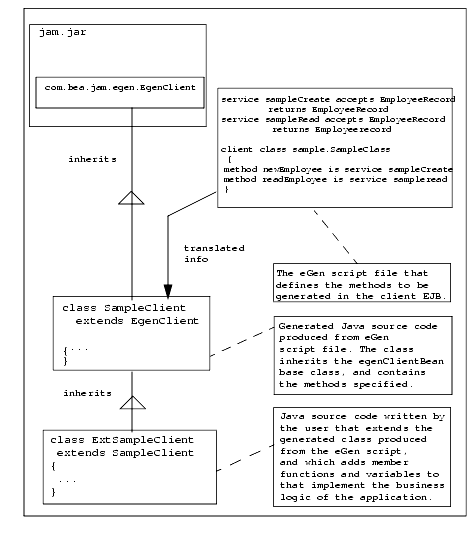


|

|
|
|
|
Generating a Stand-alone Client Application
This type of application produces simple Java classes that perform the appropriate conversions of data records sent between Java and the mainframe, but without all of the EJB support methods. These classes are intended to be lower-level components upon which more complicated applications are built.
Action List
Before you build a stand-alone application, see the following action list and refer to the appropriate information sources.
Prerequisites
Before you start programming your stand-alone application, you should complete the following tasks:
Components of an eGen COBOL Stand-alone Application Script
The following listing shows the contents of a complete script for defining a stand-alone client class with multiple services.
Listing 5-1 Sample Stand-Alone Client Class Script
1 #--------------------------------------------------------
2 # empclass.egen
3 # JAM script for an employee record.
4 #
5 # $Id: empclass.egen, v 1.1 2000/01/21 23:20:40
6 #-------------------------------------------------------------
7
8 # DataViews (typed data records)
9
10 view sample.EmployeeRecord (Comment 1)
11 from emprec.cpy
12
13 # Services
14
15 service sampleCreate (Comment 2)
16 accepts EmployeeRecord
17 returns EmployeeRecord
18
19 service sampleRead (Comment 2)
20 accepts EmployeeRecord
21 returns EmployeeRecord
22
23 service sampleUpdate (Comment 2)
24 accepts EmployeeRecord
25 returns EmployeeRecord
26
27 service sampleDelete (Comment 2)
28 accepts EmployeeRecord
29 returns EmployeeRecord
30
31 # Clients and servers
32
33 client class sample.SampleClass (Comment 3)
34 {
35 method newEmployee (Comment 4)
36 is service sampleCreate
37
38 method readEmployee (Comment 4)
39 is service sampleRead
40 }
41
42 # End
Table 5-1 refers to the numbered comments in Listing 5-1.
Processing a Script
Issue the following command to process the script.
Listing 5-2 Sample Script Process Command
egencobol empclass.egen
emprec.cpy, Lines: 21, Errors: 0, warnings: 0
Generating sample.EmployeeRecord...
Generating group emp-name
Generating group emp-addr
Generating SampleClass...
Working with Generated Files
This script command generates the following files.
|
File |
Content |
|---|---|
|
SampleClass.java |
Source for the sample class. |
|
EmployeeRecord.java |
Source for the DataView class. |
SampleClass.java Source File
The following listing contains the generated SampleClass.java source file.
Listing 5-3 Sample SampleClass.java Source File
// SampleClass.java
//
// Client class generated by eGenCobol on 24-Jan-2000.
package sample;(Comment 1)
// Imports
import com.bea.jam.egen.EgenClient;
...
/* Mainframe client class. */
public class SampleClass (Comment 2)
extends EgenClient
{
// newEmployee
public EmployeeRecord newEmployee (EmployeeRecord commarea)
throws IOException, snaException (Comment 3)
{
...
}
// readEmployee
public EmployeeRecord readEmployee (EmployeeRecord commarea)
throws IOException, snaException (Comment 3)
{
...
}
}
// End SampleClass.java
Table 5-3 refers to the numbered comments in Listing 5-3.
Customizing a Stand-Alone Java Application
The stand-alone client class model is the simplest JAM code generation model both in terms of the code generated and customizing the generated code.
The following figure illustrates the relationships and inheritance hierarchy between the JAM classes comprising the application.
Figure 5-1 The JAM Client EJB Class Hierarchy
The generated Java code for a client class application is a class that inherits class EgenClient. The EgenClient class is provided in the JAM distribution jar file. This base class, illustrated in the following listing provides the basic framework for a client to the jcrmgw. It provides the required methods for accessing the gateway. Listing 5-4 Generated EgenClient.java Class The generated class, illustrated in the following listing, adds the methods specific to the users application Listing 5-5 Sample SampleClient.java Class Your class, which extends or uses the SampleClient class, simply overrides or calls these methods to provide additional business logic, modifying the contents of the DataView. Your class may also add additional methods, if desired. The following listing shows an example ExtSampleClass class that extends the generated SampleClient class. Listing 5-6 Sample ExtSampleClient.java Contents Once it has been written, the ExtSampleClient class and the other Java source files must be compiled and placed on to your CLASSPATH.
//==========================================================
// EgenClient.java
// Basic functionality for clients of the jcrmgw
//
//---------------------------------------------------------------package com.bea.jam.egen;
public class EgenClient
{ public byte[] callService(String service, byte[] in)
throws snaException, IOException
{
// make a mainframe request through the gateway.
...
}
}// End egenClientBean.java
// SampleClass.java
//
// Client class generated by eGenCobol on 02-Feb-00.
//package sample;
// Imports
//
import java.io.IOException;
import com.bea.jam.egen.EgenClient;
import com.bea.sna.jcrmgw.snaException;
import com.bea.base.io.MainframeWriter;
import com.bea.base.io.MainframeReader;/**
* Mainframe client class.
*/
public class SampleClass extends EgenClient
{
// newEmployee
//
public EmployeeRecord newEmployee(EmployeeRecord commarea)
throws IOException, snaException
{
// Make the remote call.
//
byte[] inputBuffer = commarea.toByteArray(new
MainframeWriter());
byte[] rawResult = callService("sampleCreate",
inputBuffer);
EmployeeRecord result =
new EmployeeRecord(new
MainframeReader(rawResult));
return result;
}
// readEmployee
//
public EmployeeRecord readEmployee(EmployeeRecord commarea)
throws IOException, snaException
{
// Make the remote call.
//
byte[] inputBuffer = commarea.toButeArray(new
MainframeWriter());
byte[] rawResult = callService("sampleRead", inputBuffer);
EmployeeRecord result =
new EmployeeRecord(new MainframeReader(rawResult)):
return result
}
]// End SampleClass.java
// ExtSampleClient.java
//package sample;
// Imports
//
import java.io.IOException;
import com.bea.jam.egen.egenClientBean;
import com.bea.sna.jcrmgw.snaException;
import com.bea.base.io.MainframeWriter;
import com.bea.base.io.MainframeReader;/**
* Extended Sample Class
*/
public class ExtSampleClient extends SampleClass
{
// deleteEmployee
//
public EmployeeRecord deleteEmployee(EmployeeRecord
commarea)
throws IOException, snaException
{
EmployeeRecord erec=(EmployeeRecord) in;
if (!isSsnValid(erec.getEmpRecord().getEmpSsn()))
{
// The SSN is not valid.
throw new Error)"Invalid Social Security Number:"+
erec.getEmpRecord().getEmpSsm());
} // Make the remote call.
//
return super.deleteEmployee(commarea);
} //updateEmployee
//
public EmployeeRecord updateEmployee(EmployeeRecord
commarea)
throws IOException, snaException
{
EmployeeRecord erec = (EmployeeRecord) in;
if (!isSsnValid(erec.getEmpRecord().getEmpSsn()))
{
The SSN is not valid.
throw new Error ("Invalid Social Security Number:"+
erec.getEmpRecord().getEmpSsn());
} // Make the remote call.
//
return super.updateEmployee(commarea);
} // readEmployee
//
public EmployeeRecord readEmployee(EmployeeRecord commarea)
throws IOException, snaException
{
EmployeeRecord erec = )EmployeeRecord)in;
if (!isSsnValid(erec.getEmpRecord().getEmpSsn()))
{
// The SSN is not valid.
throw new Error("Invalid Social Security
Number:"+
erec.getEmpRecord().getEmpSsn());
} // Make the remote call.
//
return super.readEmployee(commarea);
} //newEmployee
//
public EmployeeRecord newEmployee(EmployeeRecord commarea)
throws IOException, snaException
{
EmployeeRecord erec = (EmployeeRecord) in;
if (!isSsnValid(erec.getEmpRecord().getEmpSsn()))
{
// The SSN is not valid.
throw new Error("Invalid Social Security Number:"+
erec.getEmpRecord().getEmpSsn());
} // Make the remote call.
//
return super.newEmployee(commarea);
}// Private functions
/******************************************************
* Validates an SSN field.
*/ private boolean isSsnValid(BigDecimal ssn)
{
if (ssn.longValue() < 100000000)
{
// Ops, should not have a leading zero.
return false;
} return (true);
}
]// END ExtSampleClient.java
What Do I Do Next?
Refer to BEA Java Adapter for Mainframe Scenarios for detailed examples of some of the application models discussed in this guide.

|

|
|
|
|
Copyright © 2001 BEA Systems, Inc. All rights reserved.
|